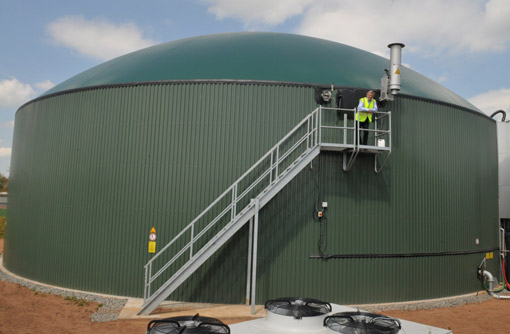Anaerobic digestion requires careful planning

Anaerobic digestion (AD) schemes require careful planning to ensure maximum return from investment, according to consultant Oliver Harwood from RH & RW Clutton.
There were 106 AD plants across the UK, with a total of 43 run on farm waste to a combined total output of 21.6MW, he said.
“Anyone going into this has to address the availability of capital and also whether there is a grid connection,” said Mr Harwood.
Farmers needed to be prepared for potentially long lead times for planning consent, equipment supply and grid connection.
There was also the requirement for environmental consents, and in some cases permitting from the Environment Agency in England, Scottish Environmental Protection Agency and Natural Resources Wales.
To make the most from the investment, he advised producers to try and find a suitable use for the heat produced as part of the process.
“Finding an optimum use for the spare heat is critical for the project; you can make a really good return if you can find a profitable use for the heat,” said Mr Harwood.
Finance
Initial capital outlay for AD was high, although government subsidies made payback periods attractive, he said.
“Government subsidies are a reasonably generous form of support which is long-standing. Once you are in the system you get it for 20 years and that’s plenty long enough.”
Banks and lenders would carry out due diligence on all projects before lending money. This included looking at feedstock assurance and supply, construction warranties, operator experience and business cashflow. “Banks were not willing to lend without security,” he said.
Key pointers: High capital costs
- Assured income over extended period with government subsidies
- Long lead times in gaining planning permission, equipment supply and grid connection
- Potential to use heat on site or sell on
Farmers also needed to be aware that cashflow would be hit in the early days as there was a lag between initial capital outlay and the point when a project generated income – planning for this was essential, he said.
Grass potential
Farms adopting AD projects were often included in the food V fuel debate, with fierce critics arguing that using crops for AD was reducing potential food production.
However, Mr Harwood argued that there was a huge potential to use grass in AD plants, especially some 400,000ha of marginal land across the UK. This included edges of golf courses and airfield strips.
“If you introduce a break crop into your rotation to fit your biogas plant, then actually you are contributing to the overall sustainability of the farm as you are not pushing it so hard for one crop such as wheat,” he added.
Oliver Harwood was speaking at a recent AD seminar and site tour in Oxford organised by Nextgen – a two-day renewable energy conference being held in Stoneleigh Park on 9-10 October.
| Incentives for AD |
|---|
| Feed-in Tariffs (FiTs) The FiT has been the key driver behind the adoption of anaerobic digestion in the UK, with the tariff rising each year in line with inflation. The current rates for AD operators are: < 250kW = 15.16p/kWh But these payments could be subject to “FiTs degression” – a policy introduced by government to limit the budget’s exposure to excessive market adoption. If there are more than 9MW of total installed capacity of plants smaller than 500kW in one year, then tariffs will fall by 20%. For larger plants, total installed capacity would need to exceed 76.9MW for a 20% degression to take place. If uptake for the FiT in the first quarter of 2013 continues at the same rate for the remainder of the year, then a 20% reduction in the FiT for plants smaller than 500kW can be expected from April 2014. Anyone putting up a plant now is advised to undergo pre-accreditation before the end of 2013, to guarantee the existing tariff rate. |
| Renewable Heat Incentive (RHI) The anticipated raising of the RHI limit above the 200kW capacity threshold provides further upside for an AD plant located beside a heat demand. While still under consultation, the RHI for AD is proposed at the following levels: < 200kW = 7.1p/kWh RHI is only available for plants that produce less than 200kWth at 7.1p/kWh. This level of heat production is only going to be of interest to a small poultry operation. A site with six large broiler sheds may demand in excess of 1MW of heat energy an hour in winter and so the introduction of these higher bands is critical. A date for announcement on the RHI amendment is expected at the end of the summer. |
| Information provided by Bidwells associate John Scott Kerr |
